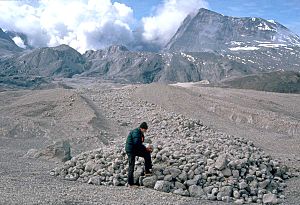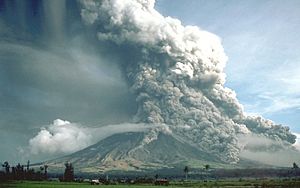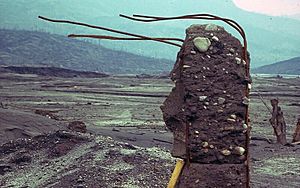Pyroclastic flow facts for kids
A pyroclastic flow is a super-fast current of hot gas and volcanic rocks. It's like a fiery avalanche rushing down a volcano! These flows can move at speeds of about 100 kilometers per hour (60 mph) on average. But they can zoom up to 700 kilometers per hour (430 mph). That's faster than a race car! The gases inside can be incredibly hot, reaching temperatures of about 1000 degrees Celsius (1800 degrees Fahrenheit).
Pyroclastic flows are a common and very dangerous result of some explosive eruptions. They usually hug the ground and rush downhill. Their speed depends on how dense they are and how steep the volcano's slope is. They can even create lightning!
Contents
What Does "Pyroclastic" Mean?

The word pyroclast comes from ancient Greek words. Pyr means "fire," and klastos means "broken in pieces." So, it means "fire-broken pieces."
A special name for pyroclastic flows that glow red at night is nuée ardente. This is a French phrase meaning "burning cloud." This name was first used to describe the terrible 1902 eruption of Mount Pelée on the island of Martinique.
Some pyroclastic flows have much more gas than rock. These are called "pyroclastic surges." Because they are lighter, they can sometimes flow over hills or even water. They might also contain steam, water, and rock that is "only" about 250 degrees Celsius (480 degrees Fahrenheit). We call these "cold" compared to other flows, but they are still deadly hot! "Cold" surges can happen when a volcano erupts under a shallow lake or the sea. For example, during the 1902 eruption of Mount Pelée, a pyroclastic surge destroyed the city of Saint-Pierre. Sadly, nearly 30,000 people died.
In science, pyroclastic flows are sometimes called PDCs. This is short for pyroclastic density current.
How Do Pyroclastic Flows Form?
There are several ways a pyroclastic flow can happen:
When an Eruption Column Collapses
Sometimes, a huge column of ash and gas shoots high into the sky during an eruption. This is called an eruption column. If the column can't stay hot enough to keep rising, it can collapse. When it falls back down, it creates a fast-moving pyroclastic flow. A famous example is Mount Vesuvius' eruption in 79 AD, which buried Pompeii and Herculaneum.
Another type of eruption, called a Vulcanian eruption, can also cause this. The gas and rocks form a cloud that is heavier than the air around it. This cloud then rushes down the volcano. The Soufrière Hills volcano in Montserrat has created many of these deadly flows.
When Lava Froths at the Vent
Imagine a giant pot boiling over. Sometimes, lava at the volcano's opening can froth and bubble a lot. This can create a type of rock called ignimbrite. This happened during the eruption of Novarupta in 1912.
When a Lava Dome Breaks Apart
Some volcanoes form a sticky dome of lava near their top. If this lava dome becomes unstable, it can collapse. This sends avalanches and flows of hot rock and gas rushing down the volcano's sides. The Soufrière Hills volcano on Montserrat also had this happen in 1997. This event sadly caused nineteen deaths.
When a Volcano Explodes Sideways
Sometimes, part of a volcano can explode outwards in a powerful side blast. This is called a directional blast. A famous example is the eruption of Mount St. Helens in May 1980. As this blast moves away from the volcano, it quickly turns into a gravity-driven pyroclastic flow.
How Big Are They and What Do They Do?

Pyroclastic flows can be small, just a few hundred cubic meters of material. But they can also be enormous, with more than 1,000 cubic kilometers (about 240 cubic miles) of material! The biggest flows can travel for hundreds of kilometers (miles). However, none that large have happened in many thousands of years. Most pyroclastic flows are about 1 to 10 cubic kilometers (about ¼ to 2½ cubic miles) in size. They usually travel for several kilometers.
A flow often has two parts:
- The basal flow stays close to the ground. It carries larger rocks and boulders.
- A super-hot ash plume rises above it. This happens because the flow mixes with the air, heating it up and causing it to expand and rise.
The powerful force of a pyroclastic flow can flatten trees and buildings in its path. The hot gases and incredible speed make them extremely dangerous. They can instantly burn living things or turn them into carbonized remains.
Here are some examples of their devastating effects:
- The ancient Roman cities of Pompeii and Herculaneum in Italy were buried by pyroclastic surges on August 24, 79 AD. Many lives were lost.
- The 1902 eruption of Mount Pelée destroyed the town of St. Pierre on Martinique. Even though there were warnings, the government thought St. Pierre was safe. But the pyroclastic flow burned almost the entire city. Only two of its 30,000 residents survived.
- On June 3, 1991, a pyroclastic surge killed three volcanologists, Harry Glicken and Katia and Maurice Krafft, and 40 other people. This happened on Mount Unzen in Japan. The surge was so powerful it climbed a hill where they were standing. Their bodies were covered with about 5 millimeters (0.2 inches) of ash.
- On June 25, 1997, a pyroclastic flow rushed down Mosquito Ghaut on the island of Montserrat. A powerful pyroclastic surge broke out of the valley. It killed 19 people who were in the Streatham village area, which had been officially evacuated. Several others in the area suffered severe burns.
What Happens When They Hit Water?
Witnesses from the 1883 eruption of Krakatoa reported that pyroclastic flows could cross large bodies of water. One flow reached the coast of Sumatra, about 48 kilometers (30 miles) away! However, this might have been a pyroclastic surge, which is lighter. A very dense flow usually can't move across the surface of water.
In 2006, a BBC documentary showed tests by scientists at Kiel University in Germany. They studied how pyroclastic flows move over water. When a reconstructed flow (mostly hot ash) hit the water, two things happened:
- Heavier material fell into the water.
- The heat from the ash made the water turn into steam. This steam then pushed the lighter parts of the pyroclastic flow even faster!
During some eruptions of the Soufriere Hills volcano on Montserrat, pyroclastic flows were filmed about 1 kilometer (0.6 miles) offshore. The water boiled as the flow passed over it. These flows eventually built a new land area, covering about 1 square kilometer (250 acres).
When a pyroclastic flow mixes with a lot of water, it can form a huge amount of mud. This mud can then flow downhill as a lahar. This is one way lahars, which are dangerous mudslides, can form.
Pyroclastic Flows on the Moon?
In 1963, a NASA astronomer named Winifred Cameron suggested something amazing. She thought that features on the Moon called sinuous rilles might have been formed by lunar pyroclastic flows. In a volcanic eruption on the Moon, a pyroclastic cloud would follow the shape of the land. This would create a winding, snake-like path. The Moon's Schröter's Valley is a good example of this.
See also
 In Spanish: Flujo piroclástico para niños
In Spanish: Flujo piroclástico para niños



